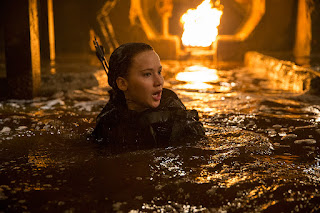The futuristic saga of a marginalized citizen of a totalitarian state who transforms into an influential revolutionary comes to a dramatic conclusion in The Hunger Games: Mockingjay – Part 2. Orchestrating the 1,200 visual effects shots for filmmaker Francis Lawrence was Charles Gibson, who had the same responsibility for The Hunger Games: Mockingjay - Part 1.
Comparing Mockingjays
The mandate from Francis Lawrence was to translate concepts from the book into his realistic version. "The two films are different in tone and execution,” observes Gibson. "Mockingjay – Part 2 was more of an action/war film with big set pieces playing within The Capitol. We had to enhance battle action and create believable environments that would hold up for extended coverage. Part 2 also required the creation of Capitol traps – "Pods” – that needed to be tentpole moments in the film.”
Collaborating with Phil Messina and Joe Willems
Key members assisting with the cinematic adaptation were Phil Messina, who was responsible for the production design for the entire franchise, and the cinematographer for the last three films, Jo Willems. "Phil and I had extensive discussions about locations vs. building digital sets; we agreed that a mix of both would be best for the film,” remarks Charles Gibson. "For the end sequence where Katniss and Gale are involved in a firefight in The Capitol, Phil built a skeleton footprint of a portion of The Capitol that was a great start for the photography; we ended up populating, modifying and extending it in all directions. With Joe Willems, it was more of a constant dialogue about what was needed on a day-to-day basis, where we needed blue screens, how we would approach a certain scene if there was to be a set extension, how we'd like a shadow to appear, and how to handle a day-for-night shot.”
The Capitol Sequence with Gale and Katniss and Snow's execution represented our biggest Green Screen efforts: containers on three sides stacked six high in order to cast the appropriate shadows. Those sequences were all handled by Double Negative, London.”
Communication was essential in making sure that there was a successful marriage between visual effects, special effects and stunts. There were quite a few BG extensions and augmentations once we arrive in The Capitol and in District 2 – making the best of existing locations and extending them.
We generally shot additional clean plates, water splash plates and lighting references with each take. We also shot standalone water splash elements, fire and explosion elements to enhance a number of shots. Weta Digital subsequently created digital water, fire and smoke for shots in which none of those elements would suffice. Weta Digital had to develop sophisticated skin shaders and a realistic ‘wet' shader, all of which had to hold up in multiple lighting scenarios and at multiple scales.
 Data collection was critical in avoiding issues with compositing, rendering, textures, lighting, shaders and camera tracking. "We had a great team of data wranglers throughout the production so there was quite a bit of information available to all of the vendors. The show used vintage anamorphic lenses from Panavision that needed to be mapped, but once that was done most of the shots were able to be tracked straightforwardly.” Gibson adds, "The show was predominantly shot on Alexa so we decided to use the Alexa native format for the show. For the few times we shot in a different format we pre-converted to an Alexa-like colour space before turning the elements over to the vendor.”
Data collection was critical in avoiding issues with compositing, rendering, textures, lighting, shaders and camera tracking. "We had a great team of data wranglers throughout the production so there was quite a bit of information available to all of the vendors. The show used vintage anamorphic lenses from Panavision that needed to be mapped, but once that was done most of the shots were able to be tracked straightforwardly.” Gibson adds, "The show was predominantly shot on Alexa so we decided to use the Alexa native format for the show. For the few times we shot in a different format we pre-converted to an Alexa-like colour space before turning the elements over to the vendor.”





No comments:
Post a Comment